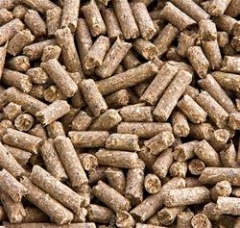Difference between revisions of "Pollard Pellets"
(→Shipment / Storage) |
|||
| Line 39: | Line 39: | ||
<br><br>Surface ventilation is recommended. However, to avoid moisture damage on the surface of the cargo, ventilation must not be performed with cold external air. The ventilation system must then be switched to return air. As with bulk cargoes of expeller, pellets are also often not ventilated. | <br><br>Surface ventilation is recommended. However, to avoid moisture damage on the surface of the cargo, ventilation must not be performed with cold external air. The ventilation system must then be switched to return air. As with bulk cargoes of expeller, pellets are also often not ventilated. | ||
<br><br> | <br><br> | ||
| − | An increase in CO<sub>2</sub> and CO content in the hold air is indicative of a vigorous heating process resp. fire in the cargo. | + | An increase in CO<sub>2</sub> and CO content in the hold air is indicative of a vigorous heating process resp. fire in the cargo. CO<sub>2</sub> has a smothering action on the seat of the fire because it displaces [[oxygen]]. |
<br><br>Note: | <br><br>Note: | ||
See also advice on overseas shipment of [[Seedcake]]. | See also advice on overseas shipment of [[Seedcake]]. | ||
| + | |||
==Risk factors== | ==Risk factors== | ||
* Self-heating / Spontaneous combustion | * Self-heating / Spontaneous combustion | ||
Revision as of 12:36, 24 February 2014
| Infobox on Pollard Pellets | |
|---|---|
| Example of Pollard Pellets |  |
| Facts | |
| Origin | - |
| Stowage factor (in m3/t) | 1.45 - 1.90 m3/t |
| Humidity / moisture | <13% |
| Oil content | 1.7 - 2.1% |
| Ventilation | See text |
| Risk factors | See text |
Pollard Pellets
Description / Application
Bran, also known as miller's bran, is the hard outer layers of cereal grain. It consists of the combined aleurone and pericarp.
Along with germ, it is an integral part of whole grains, and is often produced as a by-product of milling in the production of refined grains. When bran is removed from grains, the grains lose a portion of their nutritional value. Bran is present in and may be milled from any cereal grain, including rice, corn (maize), wheat, oats, barley and millet. Bran should not be confused with chaff, which is coarser scaly material surrounding the grain, but not forming part of the grain itself.
Wheat bran pellets are made from wheat bran, a by-product of flour and grits production, which predominantly consists of husks and variable proportions of the endosperm, by adding a suitable binder (e.g. 1 - 3% of molasses, fat or colloidal clays) and then pressing the composition under high pressure in pelletizing machines or extruders to form cylindrically shaped pellets
Bran is particularly rich in dietary fiber and essential fatty acids and contains significant quantities of starch, protein, vitamins, dietary minerals and phytic acid, which is an antinutrient that prevents nutrient absorption.
Bran is widely used as a major component in foods for cattle.
Shipment / Storage
Wheat-bran pellets, in bulk.
The risk of sweating damage is extremely high because of a substantial moisture content and heating may also occur.
Prior to loading the moisture content and temperature must be provided in writing by an independent surveyor. If the moisture contents exceeding 13% and the temperature is considerably more than the environment (liable with new product), this will cause damage by sweating and in consultation with the Agency the cargo should be refused.
The cargo is also to be checked for vermin and if any is found the container has to be fumigated. This is in consultation with the Agency at the shipper's expense.
Wheat-bran pellets are chiefly shipped in bulk and the stowage spaces should allow mechanical ventilation. The product is not to be stowed near/over heat sources (i.e. fuel tanks, hot pipework, engine-room bulkhead etc.)
The travel temperature should preferably be between 5 and 25°C. Temperatures of up to 30°C are admissible for short periods, providing the critical water content of the product is not exceeded - in order to avoid self-heating -.
Product temperatures of 25 - 55°C may occur in tropical ports; if en-route the temperatures are rising >55°C and increasing further, closing of hatch openings and injection of CO2 or inert gas should be considered.
At temperatures of 35 - 40°C within the stow, fat degradation and thus self-heating is activated.
Cool, dry. Mechanical ventilation of the stowage spaces must be possible. Do not stow over heated double bottom tanks, close to the engine room bulkhead and pipework which may become hot.
Product intended for shipping must be adequately matured. The time required for maturing is determined by the oil content. Residual oil contents of < 1.5% indicate extraction meal, while higher oil contents indicate expeller.
Seawater, rain and condensation water are damaging to the product, since moisture encourages mould, mustiness and self-heating.
Surface ventilation is recommended. However, to avoid moisture damage on the surface of the cargo, ventilation must not be performed with cold external air. The ventilation system must then be switched to return air. As with bulk cargoes of expeller, pellets are also often not ventilated.
An increase in CO2 and CO content in the hold air is indicative of a vigorous heating process resp. fire in the cargo. CO2 has a smothering action on the seat of the fire because it displaces oxygen.
Note:
See also advice on overseas shipment of Seedcake.
Risk factors
- Self-heating / Spontaneous combustion
- Odour
- Contamination
- Toxicity / Hazards to health
- Shrinkage / Shortage
- Insect infestation / Diseases











